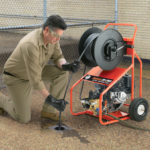Every professional drain cleaner knows that regular sewer camera inspections are essential for identifying common sewer problems before they escalate. These inspections can detect early signs of damage, such as leaks or root intrusion, that may not be visible from the surface. By using a sewer inspection camera, plumbers can visually confirm the integrity of sewer pipes and pinpoint precise locations for targeted repairs. This proactive approach saves time and prevents potential emergencies by addressing issues in their beginning stages.
However, even for the pros, navigating the challenges of sewer inspections can be scary, especially when dealing with potential blockages and damaged pipes. Imagine kneeling in wet grass next to a cleanout, carefully maneuvering your Gen-Eye X-POD Plus® inspection camera down the drain. With the push rod in hand, you’re focused on finding the source of the blockage that has troubled your customers’ toilets and drains.
As you prepare to send the camera into the depths of what might be a damaged sewer line, it’s crucial to consider the potential hazards that could arise. Let’s explore the two most common causes of drain inspection camera problems and how to avoid them.
Kinking the Push Rod
Most kinks in the push rod occur within the first few feet and typically result from a plumber shoving the rod into the pipe with a bit too much enthusiasm. This often happens when the contractor or an assistant applies excessive force, or when the operator stands instead of kneeling or crouching. Giving the push rod too much room can cause it to bow and kink.
Try to keep your hands close to the drain and take it slow. Use short, controlled motions to navigate bends, and always stay aware of your surroundings.
Challenges with Small Pipes and Debris
One particular challenge faced during a sewer line camera inspection is navigating small pipes filled with debris. These conditions can severely restrict the movement of the camera head, making it difficult to conduct a thorough inspection. It’s crucial for operators to employ small cameras designed to maneuver through narrow spaces without causing damage to the pipe or the equipment. Clearing the path of debris beforehand can also ensure a smoother inspection process, providing clearer video inspection results and reducing the risk of clogs, or damage to the camera system.
Damaging the Camera Head
The camera head is the most critical—and often the most vulnerable—component of the inspection system. Many damaged camera heads arrive at repair centers with cracked lens covers or light rings, presumably the result of being used as incredibly expensive battering rams. While your camera is sealed in a robust protective case, it’s not immune to damage from reckless handling.
Tip: Always keep an eye on the monitor! If the camera approaches a break in the pipe, a foreign object, or underwater conditions, it’s best to stop and reassess.
Conclusion
Of course, many other issues can arise with your camera system—from kinking the push rod deep in the line to accidentally severing the camera head during pipe cutting. However, by focusing on the two primary concerns mentioned, you can significantly reduce the likelihood of drain cleaning camera-related mishaps.
Some contractors never damage their camera systems, while others seem prone to frequent issues. It’s a sliding scale! Most drain cleaners and plumbers fall somewhere in between, facing occasional problems. The key takeaway is the clear relationship between technique and the frequency of repairs. Learn from experience to keep your drain cleaning equipment in top shape!
Questions? Call the Drain Brains at 800-245-6200



